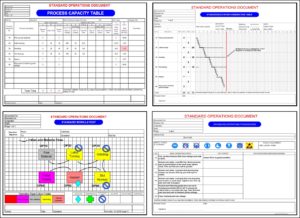
One of the Least used Tools – Standardised Work
Standardised Work is one of the most powerful but least used tools within business, yet it is one of the foundations to Lean Manufacturing
From my experience “without standards we do not have continuous improvement only chaos”.
The declarations I have heard, “we don’t make cars”, “You see, we are different”, “We’re unique….this isn’t an assembly line!”
My response to such statements is “everyone works a process that process can either be destroying or creating value added for the customer, which would you rather it be. Whether you’re building cars or delivering life-saving patient care, it takes a sequence of highly coordinated tasks and processes to deliver the end result. When this sequence of tasks is standardised, you’re on your way to fundamentally improving and eliminating significant sources of waste.”
Standardised work is the simple understanding that every task that can be repeated requires a written instruction of the most efficient and effective way to complete it to the highest quality Standard. We then use the selected standard work process each time the task is performed ensuring that the same results are achieved, in the same amount of time, regardless of who completes the task.
Now, we must understand here that the first step is to document what the current best practice is, this may be not be delivering the outcome you require currently, but without first understanding, how will you control any changes and what improvements have had what effect? We can’t, it would be guess work!
Key Elements of Standard Work
- TAKT
- Process Capacity Table
- Work Combination Table
- Work Layout
- Standard Operating Procedure
Takt Time – “Takt” is a German word which refers to the pace or beat of a musical composition, the metronome. The calculation of Takt time gives us the rate of production for meeting customer demand
Work sequence – “The time for an employee to do a prescribed task and return to his original stance.” – Taiichi Ohno
Standard inventory – In manufacturing this refers to parts, but in other sectors it can refer to applications, data inputs or other resources necessary to perform the job.
Bear in mind the following
Involve employees in the process – they are the ones who determine the best practice for each task. This also helps ensure engagement and ultimately adherence to the standard work.
Focus on the details – it must be in-depth to be useful in reducing variation. No detail should be omitted. Even the little nuances need to be understood, these are improvements that can be engineered out. (I can remember a process I worked with where the Associate had to lean on one part for the other part to fit, a stack up of tolerances had occurred. This knack had to be written in the standard work until we could engineer it out, imagine the amount of lost time/production if others weren’t aware of this)
Use visuals – Images, photographs, diagrams and examples will help bring your standard work definition to life and increase the likelihood of consistent compliance. A picture is worth a 1000 words.
Make it accessible – The documentation must be accessible at the time and place that the work is to be performed.
Innovate – While you don’t want employees deviating from the standard work process, there must be a method to give consideration to changes when new conditions or new ideas warrant revision. A governance process will increase the likelihood that changes will be analysed and approved rather than being implemented ad-hoc.
0330 311 2820
More Blog Posts







To leave me a message or book a return call at a time that suits you









